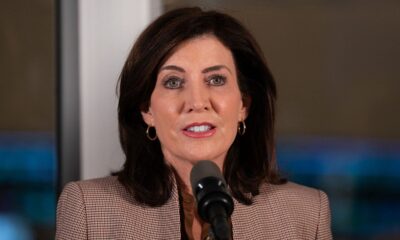Alaska
Sacred Acre Festival Gears Up In Alaska – Pollstar News

Sacred Acre is kicking off its 2024 festival with three days of music and exploration from Sept. 6 to 8. This year’s lineup features Peekaboo, The Glitch Mob, Wreckno, Zingara and more in the midst of the Alaskan landscape. While the event itself is quite isolated, the festival’s directors Chris Miller and Hannah Stearns managed to find a way to make it all happen. The two built off of their sister event, SalmonFestl, and its previous infrastructure.
“The challenge of marketing an event, especially in such a rural location, is a hurdle in itself,” Miller tells Pollstar. “Many people have this wanderlust they want to fulfill, but it’s really hard to make people take a leap of faith. This year, over 40% of ticket sales are from out of state, so I think we’re doing a good job at capturing that out of state market. It reminds me of when Jim [Stearns, festival director for SalmonFest] and Hannah were sitting around Jim’s table talking one year about, let’s book CloZee and LSDream, and we did it. But we got a lot of Fyre Festival comments right out the gate, it was really rough because we were in the middle of nowhere. There’s so many events that are popping up everywhere, and we have seen a lot of events that have taken a hard nose dive or had weather hit them really hard. People look at Alaska and they’re like, it’s going to be freezing cold or it’s going to be hard to get to. That hurdle has been a big one for us. Thankfully we had SalmonFest to help us with getting our foot in the door in a lot of regards on the lineup and artists and people to come work at the event. We already have a plug-and-play facility. It’s been really amazing to walk above some of those first-year struggles because of the SalmonFest team.”
The festival’s mission is to combat factory trawling, which damages the Arctic ecosystems. Factory trawling scrapes the ocean floor, which in turn harms ecosystems and leads to the capture and discard of unwanted marine life. Throughout the festival, Sacred Acre hosts workshops, including ones that focus on the harmful fishing practice.
The festival also features the biggest laser show in Alaska, performance art and fire dancers. Fans can also embark on excursions to see all the nature Alaska has to offer.
“We have helicopter flights leaving right from the festival site,” Stearns says. “You can go for 30-minute tours or half-day tours to a glacier. We have our Bumping on the Bay tour, which is a three-hour tour in Homer with a national DJ. There’s 24-hour programming in that space where you can go and do workshops and simply do self-improvement. Really getting in touch with yourself, that is something you can do without experiencing any of the bass music.”
In order to build the festival, SalmonFest will utilize steamships and semis. Sacred Acre uses much of the same setup as SalmonFest, making the build a bit easier. Load in takes 10-12 days, and they’ll use up to 53 semis. This year’s laser production is coming straight from Burning Man, making for a quick turnaround with the shipping process.
“SalmonFest has been able to parlay the challenges of getting here and the remoteness of it into a bit of a mystique,” Stearns says. “Last year, we sold tickets in 48 states and 17 countries. Sacred Acre has the same goal in mind, to make this a destination festival.”

Alaska
Alaska Sees Coldest December In Years | Weather.com

2 Feet Of Snow Traps Drivers In Michigan
Do you think that Alaska is cold during winter? Of course it is! However, the type of cold the state is experiencing right now if unprecedented. How about having consecutive days of temperatures colder than 40 degrees below zero!
This is true for much of the Alaskan interior, particularly near Fairbanks and in between the Alaska and Brooks mountain ranges.
Over the last four days in Fairbanks, temperatures have struggled to reach 40 degrees below zero, with organizers in Fairbanks even postponing their annual New Year’s Eve fireworks show due to the extreme cold.

The temperature in the final few minutes of 2025 in Fairbanks was 43 degrees below zero.
In other words, conditions are unbearably and dangerously cold, even by local standards in Central Alaska.
In Chicken, Alaska, located near the Canadian Border, temperatures dropped as low as 62 degrees below zero! Numerous other locations in the eastern Alaskan Interior have seen temperatures between 50 and 60 degrees below zero.
On top of bringing dangerously cold minimum temperatures, this most recent cold snap has also been more prolonged than usual.
Temperatures in much of Alaska have been largely colder than usual since roughly December 5th, 2025
Some regions in eastern Alaska and the neighboring Yukon Territory in Canada have seen combined December temperatures up to 30 degrees below the climatological average.
For reference, the average December temperature in Fairbanks from 1904 to 2025 is 22 degrees below zero with much of central Alaska having similarly cold December temperatures on average. The city has seen a temperature departure of 18.5 degrees below average for December 2025, ranking as the 8th coldest December on record.
This means that much of east-central Alaska has been stuck between 40 and 50 degrees below for nearly an entire month!
While many factors affect the severity of winters in Alaska, one notable statistic is the unusually high snowfall in portions of Alaska this past December. Fairbanks saw more than double its usual snowfall for the month of December.
Juneau, Alaska’s capital, located in far-southeast Alaska, has seen nearly its entire annual snowfall in December alone, at over 80 inches.
Snowfall promotes cold temperatures by reflecting light from the sun back to space. In Alaska, there is already very little sunlight during the winter due to its positioning on and near the Arctic Circle.
What little sunlight snow-covered portions of Alaska have seen has been quickly reflected back to space by the unusually heavy snowpack.
In Central Alaska, located between the Alaska and Brooks ranges, the heavy snowpack, lack of sunlight, and lack of transport of air from warmer locations have led to the development of an arctic high pressure system, leading to stable conditions and light winds. These conditions cause the land to rapidly lose heat, becoming even colder. With this arctic high pressure is in place, central Alaska has remained cold. However, a slight breakdown in the strength of the high will allow temperatures to warm somewhat (see forecast for next 3 days below).

Fortunately, this pattern will break down as we approach mid-January. A more active storm track from the Pacific is poised to bring wetter and warmer conditions to portions of Alaska, especially towards the middle to second half of the month. While this wetter pattern means snow for most, temperatures will improve, being far more bearable than the current temperatures in the 40 to 50 degree below zero range.
Hayden Marshall is a meteorologist intern and First-Year-Master’s Student at the Georgia Institute of Technology. He has been following weather content over the past three years as a Storm Spotter and weather enthusiast. He can be found on Instagram and Linkedin.
Alaska
Alaska’s delegation responds to situation in Venezuela

ANCHORAGE, Alaska (KTUU) – Officials say Venezuela’s president, Nicolás Maduro, and his wife are in New York Saturday night after they were captured in a U.S. military operation that came amid strikes in the country’s capital.
Alaska’s delegation has responded to the situation.
Senator Dan Sullivan commented on the situation saying, “In the aftermath of last night’s remarkable operation, America and the world are safer.”
He continued, saying in-part, “Maduro was an illegitimate, indicted dictator who has been leading a vicious, violent narco-terrorist enterprise in our Hemisphere that was responsible for the deaths of tens of thousands of Americans. He will now face American justice. The interim Venezuelan government must now decide that it is in their country’s and people’s interest to cooperate with the United States and reject Maduro’s legacy of violence and narco-terrorism.”
Senator Lisa Murkowski said the U.S. does not recognize Maduro as the legitimate leader of Venezuela.
She said in-part, “While I am hopeful that this morning’s actions have made the world a safer place, the manner in which the United States conducts military operations, as well as the authority under which these operations take place, is important. When the Senate returns to Washington next week, Congress has been informed that we will receive additional briefings from the administration on the scope, objectives, and legal basis for these operations.”
Representative Nick Begich posted his statement on Facebook. He called the situation a “lawful arrest” and said it was “a powerful and flawless execution of American power and capability.”
Begich continued, saying in-part, “Stability and accountability in the Western Hemisphere are core U.S. national interests. For far too long, criminal networks operating in our own hemisphere have exploited weak governance and corruption. The result has been poisoned streets, overwhelmed borders, and countless American lives lost to fentanyl and other illicit drugs.”
See a spelling or grammar error? Report it to web@ktuu.com
Copyright 2026 KTUU. All rights reserved.
Alaska
Opinion: Before Alaska becomes an AI data farm, be sure to read the fine print

Artificial intelligence is driving a revolution in the economy and culture of the United States and other countries. Alaska is being pitched as the next frontier for one of the most energy-intensive industries: data centers, with their primary purpose of advancing AI, socially disruptive to a degree as yet unknown.
Gov. Mike Dunleavy, the state’s biggest promoter, has invited more than a dozen high-tech firms, including affiliates of Microsoft, Facebook and Amazon, to establish “data farms” in Alaska. He has personally toured executives around potential sites in the Anchorage and Fairbanks areas. The Alaska Legislature has been a bit more circumspect, though its House Concurrent Resolution 3 (HCR 3) states that “the development and use of artificial intelligence and the establishment of data centers in the state could stimulate economic growth, create job opportunities and position the state as a leader in technological innovation.” True, however, the resolution makes no mention of drawbacks stemming from data center development.
The Northern Alaska Environmental Center (NAEC), based in Fairbanks, is examining the known and potential benefits, costs and risks of data center growth in the state. It urges a well-informed, unhurried, transparent and cautious approach.
First, though, what are data centers? They are facilities that house the servers, storage, networking and other computing infrastructure needed to support AI and other digital services, along with their associated electrical and cooling infrastructure.
Generally speaking, there are two categories of data centers. One is the massive hyperscale facility, typically operating at multi-megawatt scale and designed to scale much higher. An example is the proposed Far North Digital (FND) Prudhoe Bay Data Center. It would start with a capacity of 120 megawatts with “significant expansion potential.” Natural gas would power it.
The other kind is the micro or microgrid data center. A good example is Cordova’s Greensparc Corp/Cordova Electric Cooperative 150-kilowatt facility. It is powered by 100% renewable energy from the nearby hydroelectric plant. We concur with the University of Alaska Fairbanks’ Alaska Center for Energy and Power (ACEP) analysis that contends that such smaller and sustainable data centers, sometimes integrated into existing microgrids, are more feasible for Alaska, particularly in underserved or remote communities.
The main problem with data centers is their high to huge energy demands, especially hyperscale ones that can consume as much electricity as 100,000 homes. Cooling can account for about 40% of a facility’s energy use, though it varies. While Alaska’s cold climate is an environmental advantage, reducing the need for energy-intensive mechanical cooling systems, cooling still requires a lot of water. The NAEC advocates that any new data centers be required to minimize use and thermal pollution of waters and reuse waste heat for local heating.
The Railbelt grid already faces constraints and expensive upgrade needs. The NAEC believes that if new data centers are developed, regulatory safeguards must be in place to ensure they do not exacerbate grid shortages and raise household electricity costs.
Most electricity powering data centers still comes from fossil fuels, even as operators sign renewable contracts and add clean generation. Building fossil fuel-powered data centers would lock in high-emissions infrastructure for decades, contradicting global decarbonization efforts. NAEC suggests that any new data center be required to build or contract for an equivalent amount of clean energy generation (wind, solar, hydro or geothermal) to match its consumption.
There are many other concerns that need to be addressed when considering data centers and AI development. One is the problem of electronic waste, or e-waste. Needed upgrades to data centers result in e-waste, which contains hazardous materials. Given Alaska’s remote potential sites and limited recycling infrastructure, the cost of appropriately dealing with e-waste should be factored into data center decisions.
In their haste to recruit data centers, several states have granted substantial tax abatements and subsidies, often with limited public benefit. Alaska must learn from the mistakes made elsewhere. Before considering approval of any new data centers, legislation should be in place that ensures that the corporations that will profit do not get discounted power rates or tax breaks and pass additional costs to ratepayers, including costs for needed upgrades.
Yes, data centers provide some much-needed diversification to Alaska’s economy, but not much. They are highly capital intensive and employ many in the construction phase, but few for operation. Companies should be required to train and hire local residents to the degree practical.
Then there is the profound but scarcely recognized issue that transcends energy, economics and the environment. Data centers expand the compute available for increasingly capable AI systems. Some researchers and industry leaders argue this could accelerate progress toward AI that matches or exceeds human capabilities, along with new risks. Ultimately, the greatest cost of data centers and AI may be the changes wrought to our humanity and society, for which we are woefully unprepared.
Roger Kaye is a freelance writer based in Fairbanks and the author of “Last Great Wilderness: The Campaign to Establish the Arctic National Wildlife Refuge.” He sits on the Issues Committee of the Northern Alaska Environmental Center.
• • •
The Anchorage Daily News welcomes a broad range of viewpoints. To submit a piece for consideration, email commentary(at)adn.com. Send submissions shorter than 200 words to letters@adn.com or click here to submit via any web browser. Read our full guidelines for letters and commentaries here.
-

 World1 week ago
World1 week agoHamas builds new terror regime in Gaza, recruiting teens amid problematic election
-

 Indianapolis, IN1 week ago
Indianapolis, IN1 week agoIndianapolis Colts playoffs: Updated elimination scenario, AFC standings, playoff picture for Week 17
-

 Business1 week ago
Business1 week agoGoogle is at last letting users swap out embarrassing Gmail addresses without losing their data
-

 Southeast1 week ago
Southeast1 week agoTwo attorneys vanish during Florida fishing trip as ‘heartbroken’ wife pleads for help finding them
-

 World1 week ago
World1 week agoSnoop Dogg, Lainey Wilson, Huntr/x and Andrea Bocelli Deliver Christmas-Themed Halftime Show for Netflix’s NFL Lions-Vikings Telecast
-

 Politics1 week ago
Politics1 week agoMost shocking examples of Chinese espionage uncovered by the US this year: ‘Just the tip of the iceberg’
-

 News1 week ago
News1 week agoRoads could remain slick, icy Saturday morning in Philadelphia area, tracking another storm on the way
-

 World1 week ago
World1 week agoPodcast: The 2025 EU-US relationship explained simply


















